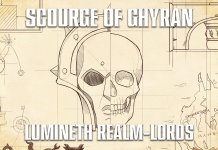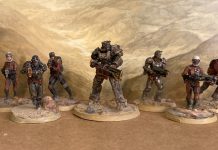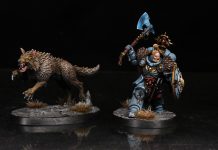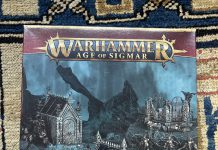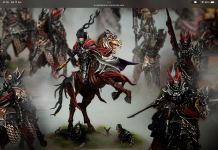Faction Overview
Why Play Sylvaneth?
Sylvaneth are a unique army in Age of Sigmar, with a model line to match that has grown out of the old Wood Elf range. In-game Sylvaneth have an unusual hit and run playstyle, are active in every phase of the game, and can happily field lots of behemoths. They utilise unique abilities to move models around the board, and as such can be highly manoeuvrable and adaptable to the flow of battle, whilst interacting with the terrain on the board more than any other army.
If you like technical, tricksy armies that reward forward planning and mastery of your rules, or if you like putting as many big trees on the board as possible, then Sylvaneth are probably the army for you.
Strengths
- Mobility – Sylvaneth have access to a lot of teleport moves, and a way to make 9” charges stick.
- Magic – Whilst they can’t go toe-to-toe with the best casters in the realms, Sylvaneth have solid wizards and ways to access bonuses to cast.
- Alpha Strike – With the right build, Big D can be hitting the enemy with his damage 6 sword from turn 1, as can your magic.
- Big Trees – Treelords are great all-rounder behemoths that provide chip shooting, solid melee and control. A march of the ents style army is totally viable in competition.
Weaknesses
- Durability – Whilst individual units can have good saves, Sylvaneth are an inherently low wound count, low model count army with a crippling weakness to mortal wounds. Your front line can often be reliant on a low number of models.
- Reliability – Sylvaneth units tend to favour a low number of high quality attacks and so feel the sting of dice swings more painfully. Furthermore, a number of key abilities across the army require a 2+ roll to happen, and a miss-timed 1 can break your battle plan.
- Points – You will see your points evaporate very quickly, with multiple 300 point single models being a staple of Sylvaneth armies.
- Techiness – This combination of strengths and weaknesses requires you to plan ahead, and failure tends to cascade for an army that can crumble quickly under pressure.

Competitive Rating
Mid Tier
Sylvaneth floats around the top of AoS’ fat middle, with a winrate settling in the low 50%s. What’s notable here is that alongside this, Sylvaneth pick up podiums at a pretty reasonable rate and have sat amongst the highest factions in TiWP* score despite the middling winrate. What keeps the winrate down is a higher representation amongst a low number of wins than the top tier factions. Overall this is indicative of an army that is strong, but has enough bad matchups that it’s susceptible to some strong matchup variance in a tournament run.
*A measure of a faction’s share of all 4-0 or better finishes.
Allegiance Abilities
Battle Traits
Places of Power
This is really two different abilities listed under one header. This hands out overgrown terrain: after territories are determined but before faction terrain is set-up, you get to pick 3 terrain features wholly outside of enemy territory to be overgrown. Combined with your own faction terrain, that’s 4 potential teleport sites right off the bat. Do note that the “wholly outside enemy territory” bit can alter how flexible your selections can be quite a lot battleplan to battleplan. In territory maps where they meet in the middle, or have some sort of L-shape, you will struggle to project power forwards with just overgrown terrain alone.
Also, during the game, if a unit starts your hero phase wholly within 9” of a tree or overgrown terrain it can heal a wound. Rarely massive, but nice and there are further sources of healing available to compound this.
From the Woodland Depths
Another grouping of two different abilities under one header, but both are providing some of the extreme mobility available to Sylvaneth.
Walk the hidden paths gives you a once per turn ability to grab a unit that is wholly within 9” of an awakened wyldwood or overgrown terrain and teleport it to another awakened wyldwood or overgrown terrain, more than 9” from enemy models. Additionally, your opponent can deny a destination point by just being within 3” of it. This is very good, as the board will be covered with potential landing points for this, and whilst many Sylvaneth units have built in mobility, this covers you for your units that do not and it adds up to an army that can by and large be where it wants to be on the board at any given time – wholly within 9” of terrain features is a lot of real estate.
Strike and fade is a standout ability for the tome, giving you a once per turn ability to teleport a unit immediately after it has fought, provided it is wholly within 9” of a wyldwood or overgrown terrain. The timing here means that your opponent won’t get to fight back, but it has been clarified that any effects that trigger on death will happen before you get to run away. The implications of this are huge: sylvaneth can be very brittle as an army, so the ability to get damage done with little recourse from your opponent is massive.
There are some things to bear in mind with strike and fade: it only works in your turn, so when the enemy charges your units you are stuck there. Additionally, if you’re intending to use this in conjunction with walk the hidden paths or another teleport and your charge fails, there’s no ability to pull that unit back – they will be stuck where they teleported to and hung out to dry.
Seasons of War
These are basically a second set of subfactions available to Sylvaneth. They’re not actually subfactions so you get to choose a glade and a season of war. These are chosen at the list writing stage.
The Reaping
Adds 3” to the wholly within ranges for the Places of Power healing and the From the Woodland Depths teleports. Not a terrible generic pick but there’s usually a more efficient option as the default ranges are typically enough. It makes the army a bit more forgiving to play, so perhaps one to keep in mind for a new player looking for ways to relax the mental load on an army that is quite technical.
The Burgeoning
Your units wholly within 9” of overgrown terrain or an awakened wyldwood get a 6+ ward, but lose it again if they make a charge move in the turn. One of only two ward saves available in-faction, probably of more use to a defensively minded army making use of the ranged capabilities of Sylvaneth.
The Dwindling
The more common competitive pick: this gives you one re-roll cast, dispel and unbind each hero phase, so long as your Sylvaneth wizard is near the trees. A lot of competitive Sylvaneth builds have pressure on their spellcasting: Warsong Revenants and Alarielle want to fish for big casting rolls, and melee alpha-strikes want to reliably have the Spiteswarm Hive up. This gets you there without burning a command trait on Master of Magic, is more flexible into the bargain and gives you some anti-magic defence as well.
Everdusk
A reverse of the Reaping in that you have to subtract 3” from the range of your Places of Power and From the Woodland Depths. In exchange, if you’re in that 6” tree-bubble you get exploding 6s to hit. Losing those 3” doesn’t generally affect your strike and fade attacks, but once battle is properly engaged it can affect your ability to pull units around the board – especially with the limitations on where your trees can be in relation to other terrain and objectives. It’s also worth noting that whilst exploding 6s is good, Sylvaneth as an army tends towards a low number of high quality attacks where it is less likely to proc, and two units in the army have attacks that already have effects that activate on a 6 to hit.
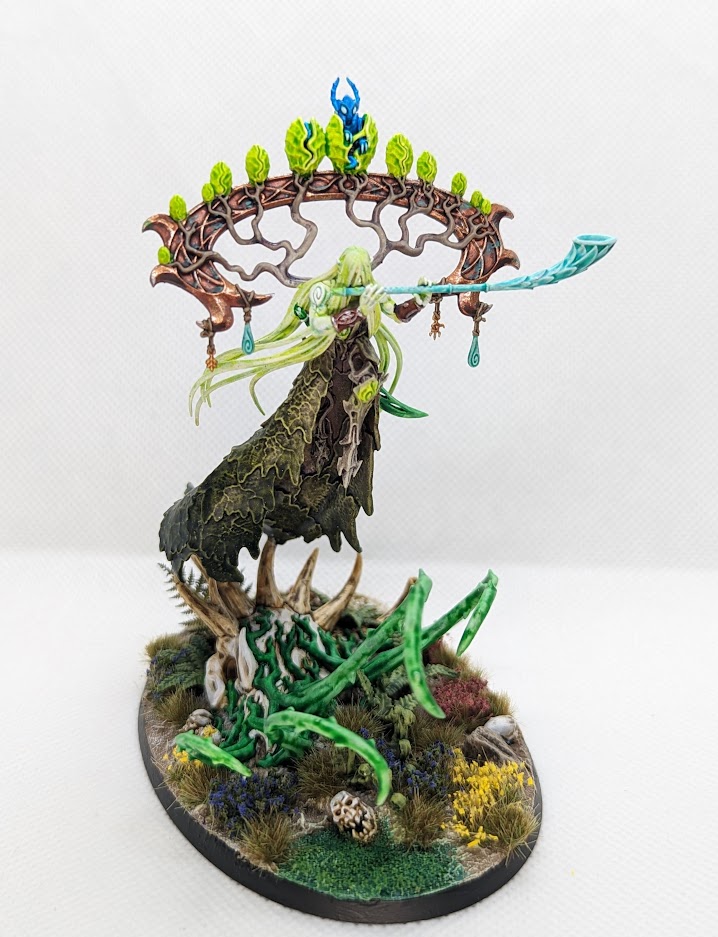
Glades
These are your subfactions proper, they tend to be highly specialised and most want to funnel you down specific builds.
Dreadwood
You get battleline Spite-Revs and two uses out of walk the hidden pathways and strike and fade, provided that at least one of the units you use is Spite-Revs. Obviously, this is the Spite-Revenant build. Battleline is big for unlocking a double reinforced unit, if you have ways of getting a reasonable number of those 15 Spite-Revs to fight (1” reach 32mm base is what you’re playing around with these) then they’re a good hammer.
As a bonus, the ability you’re getting alongside is good – two uses of the teleport is fine enough and two uses of your escape mechanism will do wonders for dictating the flow of combat and keeping your army intact. Even if your opponent gets one activation in between your uses of strike and fade, it can make situations where you are throwing your blob of Spite-Revs into a multi-unit combat much less scary.
The downside here is that this army build is incredibly specialised. Spite-Revs don’t see much play at all outside of Dreadwood, so your purchases will be getting you less variety in potential playstyle.
Gnarlroot
Probably the most common subfaction for an all-rounder build, and good into the Andtor season. You get a once per turn ability to roll 3d6-drop-lowest for a casting roll if your wizard is within 9” of overgrown terrain or a wyldwood. If you’re attempting a warsong bomb or want big rolls with metamorphosis, this will push your average casting rolls and therefore damage up. Otherwise, casting Spiteswarm Hive successfully is important for your teleport strikes.
Harvestboon
The fast get faster with your Spiterider Lancers and Revenant Seeker units getting a post-deployment 12” move. Both units also become battleline. As pre-battle moves go, this is a generous one. Unlike Nurgle flies, these are not necessarily units you want to be slamming into your opponent’s face immediately – though they are durable for Sylvaneth.
As it goes, Spiteriders don’t quite get there as shock cavalry and your Revenant Seekers have a more reactive playstyle with their ability to bring friendly models back, so this hasn’t seen much play.
Heartwood
This nets you battleline Kurnoth Hunters, which is nice. The ability also has a generic application, so you don’t need to hyper specialise in order to make use of it. After deployment you get to pick 3 different enemy units and your army gets +1 to hit them for the rest of the battle. Simple and effective, and particularly welcome on the surprising number of Sylvaneth units that hit on a 4+.
Ironbark
You get a command ability to do some chip mortals in your opponent’s combat phase if they made a charge. It’s not a lot of damage, you can’t combo it up on the same enemy unit despite being allowed to use the CA more than once, and because it’s in the combat phase it locks your unit out of all out attack/defence. You never see this.
Oakenbrow
An occasional meta darling for Sylvaneth and a subfaction that’s seen podium success. Your 3 flavours of treelord count as having suffered half the damage that they actually have for the purposes of their damage table – especially good on a Durthu as they degrade so punishingly. You also get battleline Treelords. Treelords are tough, reasonably punchy and offer up multiple levels of control at a relatively low price, so players have used Oakenbrow to skip the Dryad tax and take treelords for battleline.
Winterleaf
Enemy units within 3” can’t retreat, and if you picked the Everdusk season of war then enemy units within 3” cannot be removed from the battlefield and set up again (eg “the good teleport”). Both useful abilities, the second will not come up very often but is shockingly impactful when it does. The issue here is that the Sylvaneth playstyle itself butts up against what this wants to do, ideally you don’t want too many of your units within 3” of the enemy outside of your own turn. If your local club somehow has a Nighthaunt player running rampant, then you can use this to ruin their day I suppose.
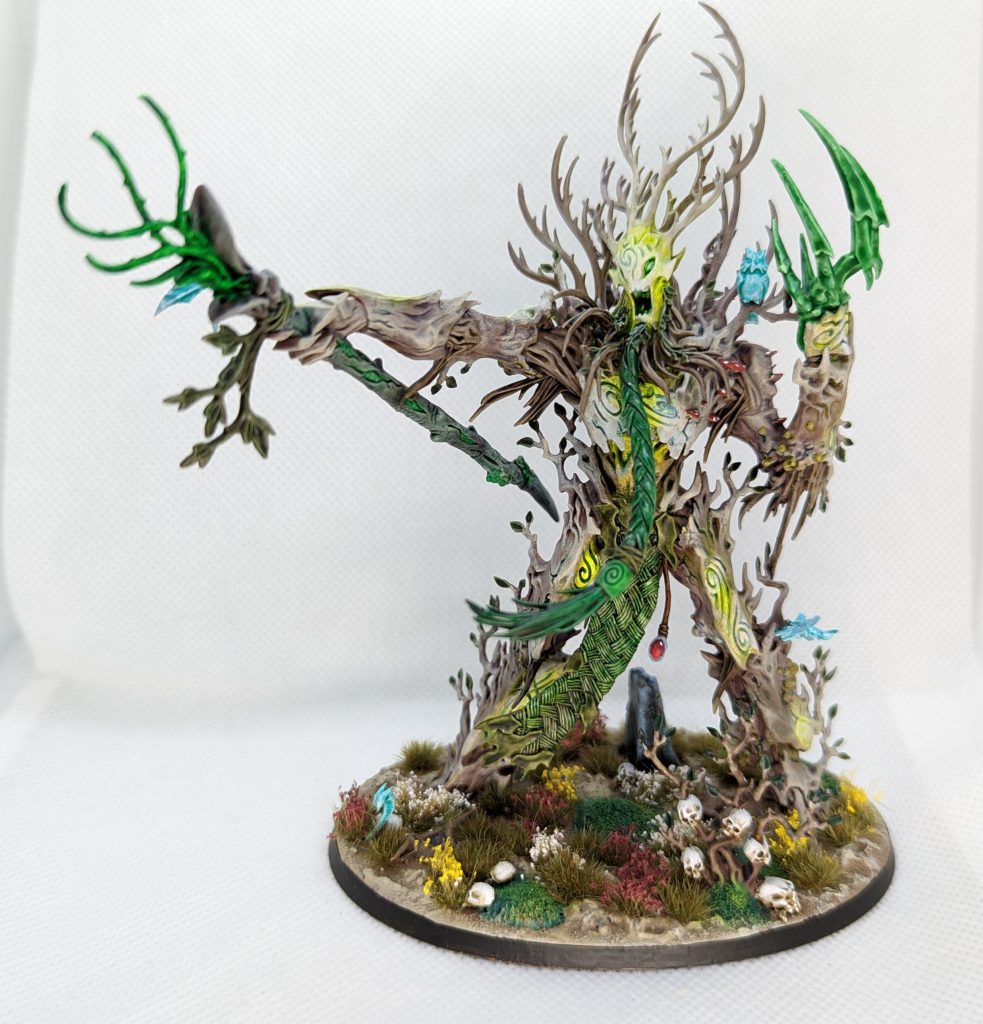
Artefacts
Depending on your unit selection, you’re probably taking the Greenwood Gladius or Versperal Gem. Otherwise, there’s a decent selection of second-rate artefacts (and the arcane tome beckons). You will find that the way Sylvaneth armies are built does not lend itself to the warlord battalion, and you’ll just have the one artefact most of the time.
Boons of the Everqueen
Artefacts for anyone.
- Crown of Fell Bowers – At the start of the combat phase you get to tag an enemy unit within 6” and your units get +1 to wound against it for that phase. Decent enough, but there’s a reasonable amount of +1 to wound already available to the army so the actual utility here is more limited. C
- Greenwood Gladius – Got a Durthu and no other pressing use for an artefact? Staple these d3 extra attacks onto his big sword. Unsubtle, but essentially mandatory for Durthu. A+
- Seed of Rebirth – The first time the bearer is killed, they get back up on a 2+ and heal d3 wounds. Sylvaneth are heavy on the important heroes, but nevertheless this isn’t your first choice. B
Relics of Nature
These artefacts are only for wizards.
- Acorn of the Ages – Once per battle in your hero phase you can pop a wyldwood up wholly within 12” of the bearer. Cute, but there are better ways of achieving this.C
- Luneth’s Lamp – The bearer gets to attempt to banish an invocation in the hero phase like a priest, and gets +2 to banishing and dispelling rolls. If your friend only plays Fyreslayers and has that one grand strategy (you know the one) then this is busted. In an all comers environment? Not so much. D
- The Vesperal Gem – Once per turn before the bearer attempts to cast a spell from the Sylvaneth lore you can use the gem and it is automatically cast and cannot be unbound. Then roll a dice, and on a 1 you take d3 mortal wounds. The spell lore here isn’t the most impactful in the game, but your melee sylvaneth will enjoy automatically having an extra pip of rend against a key target. In a world where this can auto score you a battle tactic its value has gone up. A
Command Traits
Aspects of Renewal
Command traits especially for your wizards.
- Nurtured by Magic – Once per turn if your general successfully casts a spell, a friendly unit wholly within 18” gets to heal d3 wounds. D
- Radiant Spirit – Your general gets a 12” aura to ignore spells and endless spells on a 4+. Actually a decent ability, Sylvaneth have a crippling weakness to mortal wounds. There are enough matchups where this does nothing that other options win out, but if Starborne Seraphon and Tzeentch start to become dominant, this has potential. B
- Spellsinger – If you’re running a Warsong Revenant, this is why. When your general attempts to cast a spell, they can elect to resolve the range and effect of the spell from one piece of an Awakened Wyldwood of your choice. Note this explicitly does not include overgrown terrain. This is one part of the engine that creates the infamous “warsong bomb”. S
Aspects of War
Command traits for anyone.
- Gnarled Warrior – Your general becomes ethereal, with all that entails. Decent on a Durthu with its 3+ save, and frees up your defensive resources to stack elsewhere. B
- Lord of Spites – Another defensive option, this subtracts 1 from the Attacks characteristic of melee weapons of enemy units within 3”. -1 Attack is a very solid debuff and will gut units like Grave Guard who rely on quantity of attacks to push damage through. That it does nothing against ranged attacks and doesn’t quite synergise with the hit and run playstyle make it a less common pick. C
- Warsinger – If you’re in a situation where your general is an Arch-Revenant, common in Alarielle builds, then this will be your bread and butter. You get a 12” aura of +3 move for Sylvaneth units. This may seem a bit odd for an army that teleports so much, but you will still be doing some regular moving and certain units in the army – Treelords and Kurnoth Hunters in particular – are quite slow by default, so this does help. B
Spell Lores
Verdant Blessing
Every Sylvaneth wizard knows this in addition to any other spells, you don’t have to spend enhancements to get it (or add to it). For CV6 you get to put an Awakened Wyldwood wholly within 18”. The wholly makes this a little tough to use, especially given the restrictions around placing Wyldwoods around terrain and objectives, as your wizards are quite likely to already be clustered around terrain. Either way, it’s free and you always have it if you need it.
Lore of the Deepwood
For an army with so much magical focus, this is a surprisingly weak spell lore, but there are some gems.
- Deadly Harvest – CV6. This is an odd little 3” range nuke, hitting everything in range for d3 mortal wounds. The deployment restrictions on Wyldwoods mean you can’t combo this Spellsinger unless your opponent walks into it. Worth remembering with Alarielle if you start a turn surrounded, otherwise a skip. D
- Regrowth – CV5. A d6 wound heal to one of your units, with an 18” range. Most Sylvaneth builds run lots of Kurnoth Hunters or Treelords, both of which are good recipients for a big heal. Being a d6 does make it very swingy. B
- The Dwellers Below – CV7. A 12” range nuke, this is a classic “roll a dice for every model in the unit” job, where you do a mortal wound on a 5+. If we’re still in a zombie and ghoul horde meta, this can do a decent job. Again, the range here is a bit disappointing and there are many matchups where this will yield incredibly poor results. C
- Throne of Vines – CV9. Once a classic, this now heals the caster for one wound at the end of each phase. A decent little effect, but for a faction without any inherent static bonus to casting, and wizards with a low number of casts, this CV is brutal. C
- Treesong – CV7. An unusual setup with a good payoff, pick an Awakened Wyldwood within (not wholly, thankfully) 16” of the caster and then any of your units wholly within 9” of that Wyldwood improve their rend in melee by 1. It’s a bit of work, but you can at least Treesong it for a long range melee strike. Excellent for sword-Hunters and Durthu who can struggle a bit with their rend, but a bit redundant for scythe-Hunters. A
- Verduous Harmony – CV7. Pick a friendly unit wholly within 18” and pop a slain model back into the unit. If it’s a unit of Dryads, Tree-revs or Spite-revs then you get d3 models instead. Bringing back an entire 5-wound, 3+ save Kurnoth Hunter is obviously very strong indeed, and anything that will keep your inevitably tiny army on the board is important. B
Battle Tactics
This section is now a hugely important aspect of the overall strength of a faction – a good set of these can really ease out scoring for an army. Sylvaneth have a decent but unspectacular set of battle tactics, you will dip into them but you will also need to be able to score GHB tactics.
- Balance the Cycle – Pick an enemy unit within 12” of overgrown terrain or an Awakened Wyldwood and kill it… with a unit that you summon that turn. Alarielle is your only unit with summoning that can bring in anything with enough offensive ability to be finishing off a unit reliably, and even then you have to make a 9” charge. Situational and requiring multiple steps of non-trivial dice rolling isn’t it. D
- Eradicate Trespassers – Pick an enemy unit within 6” of an Awakened Wyldwood (but not overgrown) and kill it. The timing on this means your opponent has to already be sitting on the tree, so you can’t drop one and score it in the same turn. No stupid extra clauses make this a regularly doable battle tactic. B
- Harness the Spirit Paths – Make a charge with a unit set up by From the Woodland Depths. Two paths to success here: you can either teleport a unit and make the 9” charge or you can make an easier charge with a footslogging unit and then use strike and fade. This tactic plays into what your army wants to be doing every turn anyway, so whilst it is dice-based you will use this every game. A
- March of the Forest Lords – Pick an enemy monster and kill it with a Durthu, Treelord or Treelord Ancient. Tough to evaluate in a vacuum, it’s either going to be pretty doable or it isn’t based on your opponent’s list, but you’ll be glad that it exists when it comes up. C
- Unleash Ghyran’s Wrath. Pick a Syvlaneth wizard, you score this if that wizard destroys an enemy unit with a spell or endless spell. It’s imperfect, but it’s doable. Alarielle and the Warsong both have high-impact spells that can take a punt at this in a pinch, and there’s always situations that can come up with enemy units floating around on a single wound waiting for an arcane bolt. That this is essentially now a copy of a GHB battle tactic and isn’t fantastic is a shame, as it does artificially limit your total number of battle tactics to an extent. C
Grand Strategies
Take a generic one instead. If you’ve got a Warsong general, Spellcasting Savant is a great pick in Andtor.
- Chorus of the Woodlands – Complete 4 battle tactics and every battle tactic you complete is a Sylvaneth specific one. You just read the list of battle tactics. F
- The Roots of Victory – Do you want to win more? Have an Awakened Wyldwood in each table quarter (one in the middle will accomplish this, at least) and have no enemy units within 6” of any of your Awakened Wyldwoods. Almost any other positioning grand strat will be easier to control than this. D
- Vengeance and Spite – Kill your opponent’s general with an Outcasts unit, ie Drycha or Spite-Revenants. Both of those units can be decent hammers, and Drycha even packs some acceptable shooting to snipe with. It’s putting a lot of control over this tactic in the hands of your opponent – you have no control over what model is their general. It’s also very obviously skewed to one particular build and useless outside of it. F (but a generous B for Dreadwood)
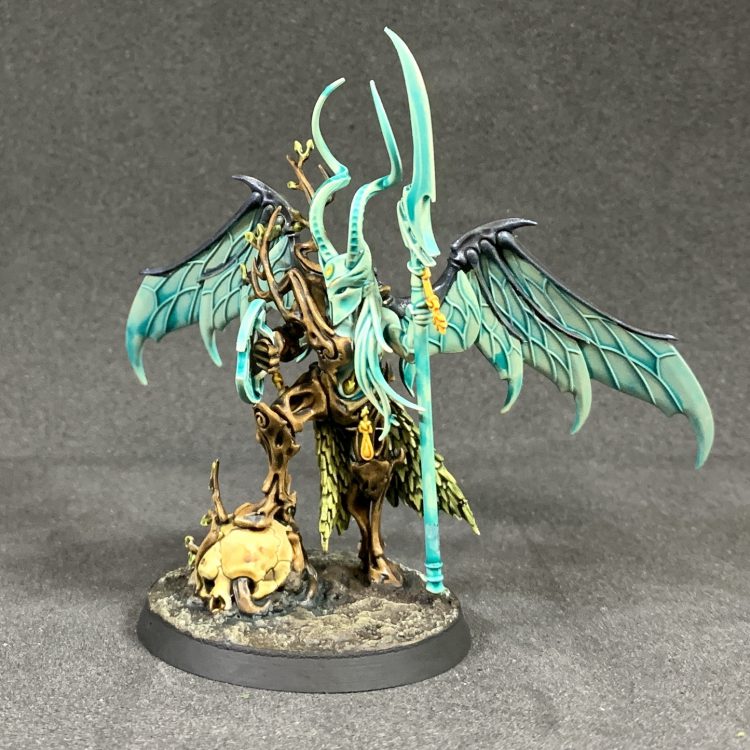
Units
Heroes
Alarielle the Everqueen
The Sylvaneth god-model is a unique take on the concept, being more of a finesse piece as befits the army. General consensus is that she’ll struggle to earn her points, but people have found consistent success with Alarielle armies.
Defensively she has 16 wounds with a 3+ save and nothing else, instantly making her the most fragile god-model by a wide margin. What she can do instead is to heal 2d6 wounds in your own hero phase, and if she dies she has a once-per-game ability to come back to life on a 6+ where you add the number of the current battle round to the roll. The idea is if your opponent under-commits she’ll heal back to full, and if they overcommit then she can just come back. Issues arise with her points cost and how little your opponent has to commit to kill her – she’s a Treelord with 2 more wounds. If she does die, you’re still down your 820 point centrepiece and you’re gambling on a dice roll to get her back. Generally you’ll be waiting for battle round 4 for a decent shot at the roll, and by then it’s probably too late for her to contribute much.
Beyond this, she has quite a lot going on her scroll. Her single shot ranged attack has a massive range and a spicy 6 damage at full bracket, likewise her beetle mount gets to make 4 damage 5 attacks in melee – but that’s basically it for her damage output, you’ll get more out of a Durthu.
She’s a 3 cast wizard that knows the whole lore, which is nice, but gets no cast bonus. Metamorphosis is her warscroll spell and similarly to Skragrott it picks an enemy unit and rolls a number of dice equal to the unmodified (i.e. no primal dice) casting roll and does a mortal wound for each 3+. It’s a good spell, but the 16” range is limiting given you will likely be playing her around strike and fade a lot.
She gets a once per game summon: 20 dryads, 10 tree-or-spite-revs, 3 kurnoth or a treelord. This is good, and if you’re someone who bakes the summon into the cost of the parent unit makes her an easier pill to swallow. She can retreat and still shoot/charge, which is always very handy when it shows up, and she gets a once per game ability to count every terrain feature on the board as overgrown.
Overall then she’s a good representative of Sylvaneth in a single warscroll – a jack of all trades, a master of none and full of tricks.
Arch-Revenant
A little non-casting foot hero with a specific job to do: buff Kurnoth Hunters. They hand out +1 to wound for Kurnoth wholly within 12” (for shooting and melee, so bow-Hunters benefit) and have a command ability for +1 attack in the combat phase. Otherwise, they’re decently fast with a 12” move and have a gimmick to gain either a 4+ ward or +1 attack at the start of the combat phase. Their attacks are damage 1, so take the ward. For 120 points you will take these if you’re investing heavily in Kuroth Hunters and you won’t take it otherwise. Kurnoth can be a viable strategy but are currently more commonly seen in Alarielle builds than spammed.
Branchwych
Standard one-cast foot wizard, quite expensive at 130 points for how much more you generally want other casters. Their main job here is to be a budget Warsong Revenant, as they have the exact same spell. Warsong are better at the job with their inbuilt +1 to cast, toughness and extra casts so Branchwyches rarely make the cut when points are as tight as they can be in Sylvaneth lists.
Drycha Hamadreth
Not always the most common pick, but Drycha has a spicy warscroll and can pack a lot of damage. With 10 wounds behind a 3+ save and no ward, she’s fragile and her warscroll spell is a poor bravery-related mortal wound spell but otherwise it’s all good news. She’s a warmaster and a wizard, and has the monster keyword despite her low wound count – so gets to rampage. If you’re running Spite-Revenants, she has a big 18” aura of +1 to wound for them, this is great to have if you’re doing that build but she has enough going on that you don’t have to force Spite-Revs into your list if you want to run her.
For damage output she has some decent quality slashing talons and some very unusual bug-based attacks. She has two weapons with 10 attacks each, 3s to hit and wound with a pip of rend and damage 1 – one is a melee weapon and the other is a shooting attack with a 12” range. The spice here is that at the start of the battle round you can pick one of these profiles to instead gain 20 attacks, and both profiles do a mortal wound on a 6 to hit. This gives her an unusual profile with a very high quantity of attacks for a single model, a very respectable output, and with the 20 attacks on her shooting she can have a potentially scary unleash hell potential.
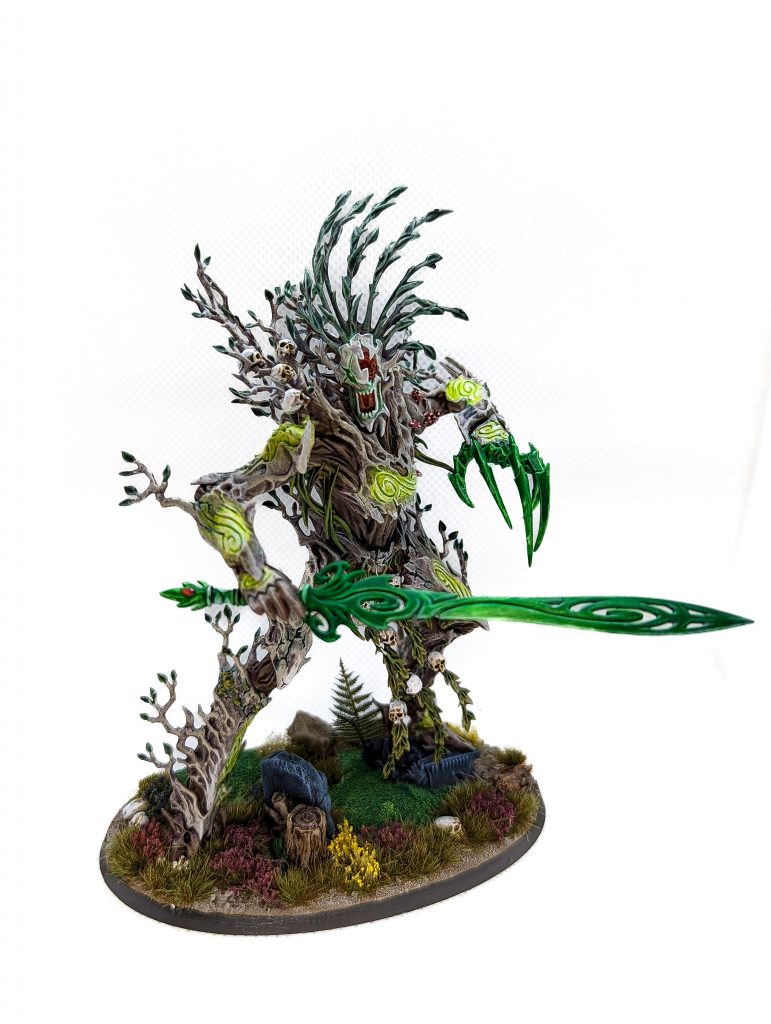
Spirit of Durthu
Durthu is a beatstick with a low volume of high quality attacks. With fewer Sylvaneth armies running large blocks of Kurnoth Hunters, this has become the troubleshooting melee threat of choice. One thing to be aware of is that whilst the default treelord defensive profile is quite tanky, the lack of any kind of inbuilt ward and the horrific degrading profile on a Durthu (with the Guardian Sword going from damage 6, to d6, to d3, to 1) have lead to a playstyle of the “Durthu castle” – where it’s the primary user of strike and fade, returning back to the wood deep in your deployment zone ready to use Spiteswarm Hive and teleport out again with less chance of taking damage in return. If you’re going for this playstyle you will want to staple the Greenwood Gladius to the warscroll and also have a Treesong or Hoarfrost available, as that 6 damage sword is “only” rend -2 and can struggle into stacked saves. This strategy has a very high ceiling of what you can achieve with it, but do be aware that there are multiple points of failure (casting hive, the hive 2+, making the charge, Durthu’s low volume of 3+ to hit and wound attacks)
The Lady of Vines
The new named character on the block, and she has struggled to make a big splash on the competitive scene. She has three primary gimmicks: a 12” wholly within spell providing a 5+ ward (handy if it goes off, but it’s on a 7 and she has no inherent bonuses to cast), a once-per game ability to summon 10 Dryads on a 2+ and an ability to count units wholly within 6” of her as being wholly within 6” of an Awakened Wyldwood. The errata on this latter ability makes it clear that you can use this ability to teleport units away from her, but not to teleport to her.
On top of this, she can make herself -1 to be hit in the combat phase, has a mini version of Alarielle’s shooting attack with rend -1 and d6 damage, and has a deeply mediocre melee profile. Overall, she’s inefficient as a warscroll and her big spell gimmick can lack synergy with the playstyle Sylvaneth most commonly enjoy. She’s not unusable and players have had reasonable success with her using the ward to anchor a battle line, but it’s not the most common path to success for the army.
Treelord Ancient
A standard Treelord melee and defensive profile with a two-shot gun that packs a cheeky damage 3. On top of this the Ancient is a single-cast wizard with a poor warscroll spell and a 330 point price tag. At first glance, it’s pretty awful. You take this because of its once per game ability to guarantee setting up an Awakened Wyldwood with no range restriction. This ability opens up your first-turn alpha strike (in the form of both spellsinging Warsong bombs and Durthu/Kurnoth strike and fade assaults), which in turn also lets you deploy your army in a safer castle than if you had to try and project those trees further up the board with Verdant Blessing.
Warsong Revenant
We keep mentioning the “Warsong bomb” so this is it. The Warsong Revenant is a two-spell caster with an inherent +1 to cast/dispel/unbind if it’s near overgrown or awakened wyldwood terrain. This already makes it the best caster in the army, but the spell is what makes the bomb. Upon casting you roll a number of dice equal to the casting roll for each enemy unit within 9” – doing a mortal wound for each 5+ rolled. Given how treesinging works and your ability to put an awakened wyldwood within 3” of an enemy unit – this has potential to hit your opponent turn one and to push out a lot of spread damage. This is also where your ability to use 3d6-drop-lowest and reroll casts come in, to help fish for those big casting rolls. Note that a very early FAQ for this GHB means primal dice don’t add to the damage total, and neither does the +1 (an inelegant and unfortunate casualty of this otherwise needed FAQ).
Beyond this, the Warsong is a 7 wound model with a 4+ ward – the wound count pulls it under certain caps that have been used through various GHBs and the ward makes it surprisingly tanky – especially with its penchant for sitting behind a wyldwood making it untargetable by most shooting. If it does end up in melee, 5 attacks with damage 2 and 3 more damage 1 attacks mean it isn’t entirely helpless.
Ylthari
Don’t bother.
Battleline
Dryads
Solid generic battleline. 100 points gets you 10 bodies with 1 wound and a 5+ save, but a fast movement at 7”. Their output is nothing, but if they’re wholly within 9” of overgrown or awakened wyldwood terrain, they’re -1 to hit and wound – a huge swing if they end up in a trash-fight, or for keeping a screen alive longer than expected.

Tree-Revenants
110 points for 5 models with 2 wounds and a 5+ save. Their attacks are OK, with a pip of rend on an otherwise generic statline. Their martial memories ability lets them use All-out Attack or Defence for free, but not in addition to your other uses of it – so this is of secondary concern really. It’s nice when it happens.
Their standard bearer gives them a 6” pile-in (not the “good” version of this rule, they still have to be within 3” to be eligible to fight), but the reason you see these so commonly, and why they can be a good ally pick depending on GHB battle tactics, is their Musician ability to teleport. Uniquely for Sylvaneth this is a completely normal teleport ability, they don’t have to start or finish it near any kind of tree. This makes them less predictable than the rest of your army, and they can be sat at your absolute backboard edge and be objective threats and battle tactic securers par-excellence.
Other
Gossamid Archers
Remember when these were going to break Age of Sigmar? Two shots with their bows that are without rend, but do d3 mortal wounds on a 6 to hit, provides reasonable output and can spike some horrific damage but they have a very limited range. Their big, gamebreaking rule is that after unleashing hell they can retreat on a 2+ if there are still enemy models within 3”. This obviously makes them incredible at kiting melee armies and if the ability keeps working, your opponent really doesn’t have any counterplay beyond having enough units to make multiple charges into them each turn, or removing casualties in such a way that they turn off the retreat but can still pile into range of attacking afterwards.
These are decent, and can do very good work in the right situation. In the wrong situation (let’s say your opponent has any ability to remove them at range, or you fail that 2+) they are prohibitively expensive at 210 points for 5 models. You do see the pop up from time to time in armies that do well, usually alongside Alarielle to help protect her.
Kurnoth Hunters with Kurnoth Greatbows
The long ranged terror of first edition. The baseline for “powerful shooting” has moved on quite a bit – but greatbow hunters still provide value. As a ranged unit they still output solid damage, though be prepared to staple all out attack to them, with an excellent 35” threat range; and as kurnoth they have a 5 wound, 3+ save defensive profile that requires heavy hitters to actually remove. Whilst they can be tied up with chaff, their melee threat is enough that it can’t just be 1-wound 5+ save stuff. This gives you a unit that can put out a respectable base of fire whilst offering control over the board that they occupy. They don’t tend to appear massively often in ‘general’ Sylvaneth lists, but have found success supporting Alarielle.
Kurnoth Hunters with Kurnoth Greatswords
The eternal debate with Sylvaneth players: sword or scythe? Swords get 4 attacks with rend -1 and damage 2, but hit rolls of a 6 do 2 mortal wounds instead. They’ve traditionally lost out to scythes owing to the latter having a reliable rend -3 for cracking armour and a 2” reach for fighting in ranks. With the last battlescroll opening up units of 6 models to fight more freely and these coming down in points, the balance shifts in the favour of swords. Points are so tight in Sylvaneth that these coming down 30 points does meaningfully open up options to take them where none previously existed.
Kurnoth Hunters with Kurnoth Scythes
See the comment on greatswords, rend -3 and damage 2 is an attack profile that a lot of armies will find intimidating, and most opponent’s will have at least one unit that’s a tough enough nut to crack to be a valid target. The problem that both flavours of melee-kurnoth have faced recently has been the playstyle of successful Sylvaneth lists – that rely on control and a more limited number of active threats to be striking and fading with and in that context, a greenwood gladius Durthu is a much more effective damage dealer than kurnoths for cost.
Revenant Seekers
Multi-purpose Sylvaneth air cavalry. You get an attack profile that’s pretty decent bar hitting on 4s, you get 5-wounds behind a 4+ save for each model and the unit heals any wounds assigned to it at the end of the phase if it kills anything. So far, fine. The main reason this unit has popped up in competitive builds is its ability to bring a 5-wound-or-less model back into a Sylvaneth unit at the end of the movement phase on a 2+, with a relatively generous wholly within 12” range.
The use case for these, then is A) as a decent fast hammer in their own right and B) bringing kurnoth hunters/other seekers back to life. Big blocks of kurnoth are a bit out of vogue at the moment, but if that’s the route your list is going down then Revenant Seekers make an excellent accompaniment.
Spiterider Lancers
Cool models that just never made it. Nominally a fast, melee alpha strike unit they just don’t hit hard enough and don’t do anything else outside of that. They get strikes-first when they charge which is nice, but strike and fade being single-use per turn actually gets you less leverage out this than other armies would. Being out-damaged by both Revenant Seekers and Kurnoth Hunters really is the nail in the coffin of these, as the points saved aren’t aggressive enough to be worth chasing.
Spite-Revenants
The cheapest unit in the Sylvaneth arsenal, but only a conditional battleline so rarely seen. They get 3 attacks base that do mortal wounds on 6s to hit so handily out-damage tree-revenants. These can be a decent if unspectacular hammer in Dreadwood, in which case you’re building entirely around them.
Skaeth’s Wild Hunt
An Underworlds warband with the usual nightmare collection of attack profiles. Largely garbage, the notable rule here and the reason you do see them occasionally is that Karthaen is a wizard with a +1 to wound warscroll spell.
Behemoth
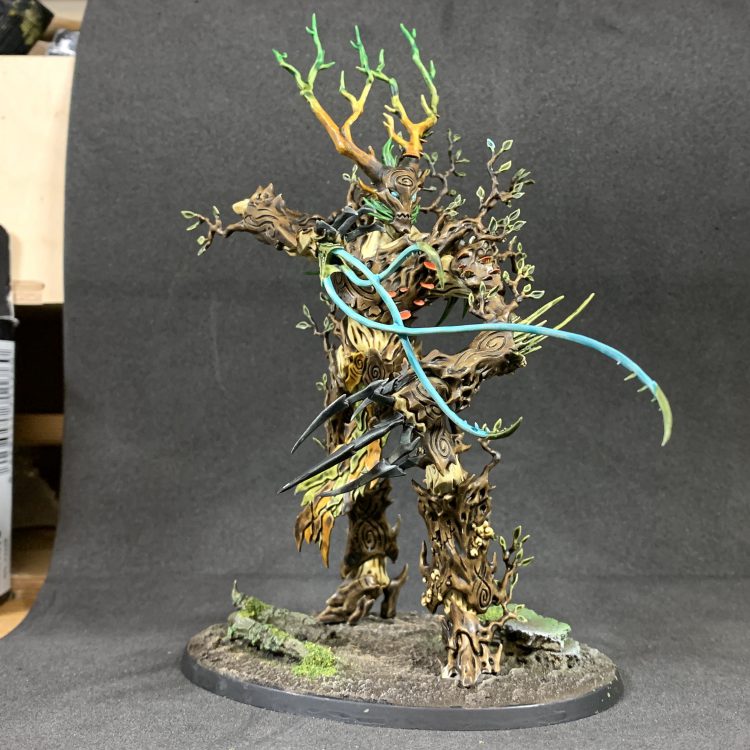
Treelord
The current Sylvaneth meta darling the humble Treelord is reasonably tough, hits decently hard and packs a surprising amount of control at a low cost. For 230 points they share a lot of the same kit as the hero-treelords: 14 wounds, a 3+ save, a warscroll teleport that gets around the once per turn limit of the battle traits and a monstrous rampage that inflicts strike-last on a 3+. In addition to this, they have their own unique ability that prevents a unit from piling in if hit with any melee attack from the Treelord. At full health Treelords have 7 attacks, 2 of which hit on a 2+, so this ability is relatively likely to stick.
What this allows Treelords to do is corner tag units, make them strike last and then stop them from piling in, whilst your Durthu gets to ruin something else’s day and strike and fade away first. Being anchors like this controls board space and helps prevent your castle from getting instantly overrun by all of the very fast armies that exist in AoS.
Endless Spells
Gladewyrm
An interesting bit of design: after the gladewyrm moves enemy units within an inch take d3 mortal wounds on a 3+ and Sylvaneth units within 6” heal d3 wounds on a 3+. Downsides are that it’s slow, has a poor cast range and just competes with far better spells.
Spiteswarm Hive
If you’re playing Sylvaneth you take this endless spell, consider it a tax to make your rules work. For 40 points you get a buff piece with two potential modes. Vital venoms picks a friendly unit wholly within 9” and gives them +3” to charge on a 2+. This is your bread and butter, and how you can get teleport attacks out with a Durthu castle. Alternatively you can use shielding swarm, which also targets a friendly unit wholly within 9” and on a 2+ worsens incoming rend by 1 for that unit. This is also a great ability, and worth remembering once your opponent has closed into you. It sucks as design that this one endless spell is so crucial, and that it can just fail to work. Still, you take it.
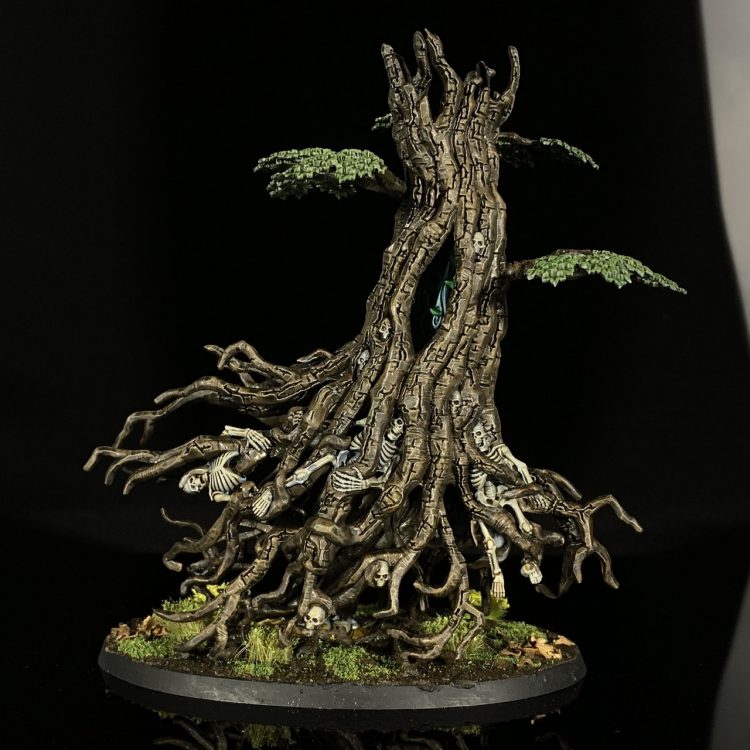
Vengeful Skullroot
The most obscene miniature in warhammer is all offence. It’s got your typical endless spell nuke of d3 mortal wounds on a 2+ to anything it moves over or finishes a move within an inch of, and gets a cheeky boost to d6 mortals if the target unit is near an awakened wyldwood. In addition, if an enemy unit fails battleshock within 3” of it, an extra d3 models flee, which is fine but you have no real way of chasing. At the 50 point price bracket it’s competing with better generic endless spells, but if you want to take it it’s by no means bad.
Faction Terrain
Awakened Wyldwood
With so much of this article talking about the damn thing, the warscroll for these is amusingly light. It’s a wyldwood so can block line of sight – your unit needs to be able to draw 3” of wyldwood between itself and the opponent and units with 10 or more wounds get to ignore this anyway. With the awakened version, Sylvaneth get to avoid any line of sight blocking at all for themselves, which is nice.
Otherwise, there’s an ability to maybe do d3 mortal wounds to an enemy unit within an inch of one of these at the of the charge phase. It does come up.
What’s key about this is if your opponent has any bright ideas about smashing an awakened wyldwood to rubble, this is all you will lose. Your ability to teleport to and from, to cast spells through and to target awakened wyldwoods with effects are all allegiance abilities or abilities on other warscrolls – not on the awakened wyldwood scroll itself.
Putting It All Together
Whichever route you go down, Sylvaneth are an army that rewards forward planning. Striking and fading is a cool mechanic, but Age of Sigmar is a game that’s about more than just killing your enemy – as a Sylvaneth player your natural gameplan doesn’t obviously play into the objective game like, say, an Orruks. It helps to have an idea about your battle tactic selection in advance, and to deploy accordingly. Are you running the castle? A warsong sitting right on the board edge is great for scoring an almost guaranteed magical dominance. Can your dryads be set up to provide both a screen and an immediate surround and destroy? Consider if going first is right for you in a given matchup. If the meat of your army is impossible for your opponent to reach then letting them have that early double in 2 can be a boon if you’re able to keep up with scoring.

